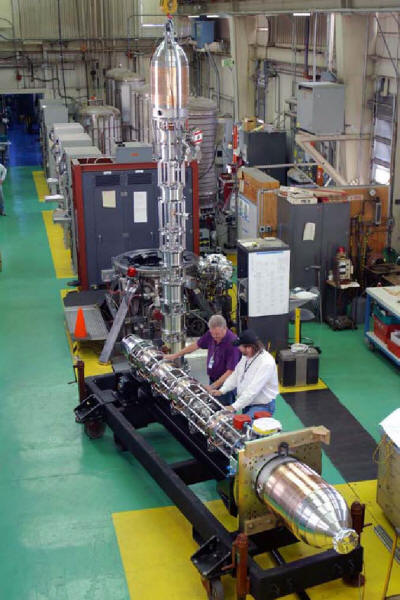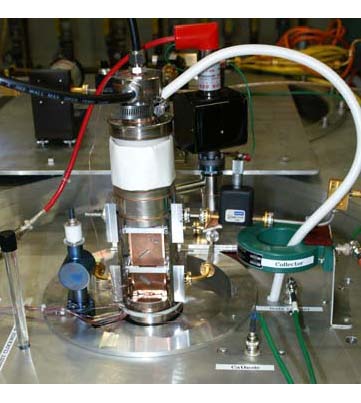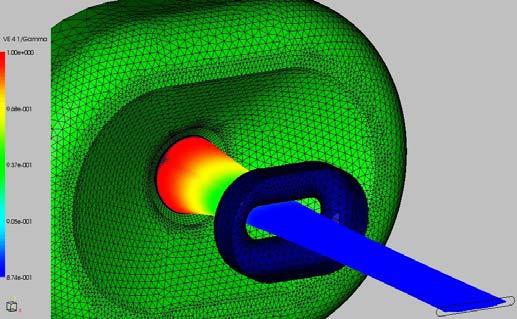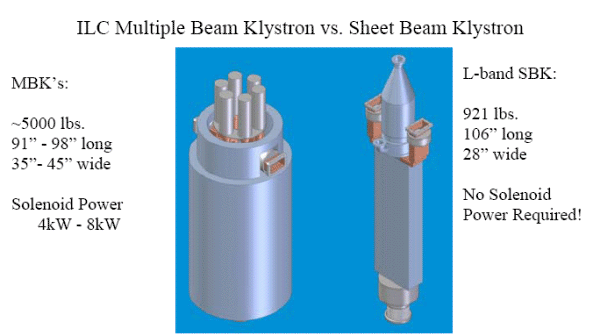11. FY06 Progress in the Klystron Department
by Chris Pearson
Appendix B Self-Evaluation FY2006
Return to Table of
Contents
The SLAC Klystron and Microwave Department is
primarily involved in the development and manufacturing
of klystrons and other high power microwave components
for use on present and future HEP and BES programs. The
department is also responsible for the operation and
maintenance of these klystrons and supporting RF
systems.
Klystron
Manufacturing
During FY06, the department’s manufacturing group
produced ten 5045 klystrons for the SLAC Linac, four of
the 1.2 MW CW klystrons used in the SLAC B-factory
storage rings, and one XL4 klystron for the LCLS
injector. The group also produced a variety of R&D RF
and vacuum electronic devices (some of which are
described in paragraphs below), including a new RF Gun
for LCLS, a new RF window for ILC L-band accelerator
structure and component testing, and various components
used for Advanced Accelerator RF Breakdown Research.
 The 5045 klystrons are 65 MW peak pulsed power S-band
klystrons which are the RF power source for the SLAC
2-mile accelerator (These klystrons are also the RF
source for the SPEAR3 injector). Although this klystron
(developed at SLAC in the 1980’s) has been in production
for many years, the lifetime and reliability of this
klystron continues to improve. Current mean time between
failures is 65,000 hours. There are now more than 25
gallery klystrons with over 100,000 operating hours. The
department also manufactures the sub-booster klystrons
providing drive power to the 242 5045 gallery klystrons. The 5045 klystrons are 65 MW peak pulsed power S-band
klystrons which are the RF power source for the SLAC
2-mile accelerator (These klystrons are also the RF
source for the SPEAR3 injector). Although this klystron
(developed at SLAC in the 1980’s) has been in production
for many years, the lifetime and reliability of this
klystron continues to improve. Current mean time between
failures is 65,000 hours. There are now more than 25
gallery klystrons with over 100,000 operating hours. The
department also manufactures the sub-booster klystrons
providing drive power to the 242 5045 gallery klystrons.
The B-factory storage ring klystrons (see
photo) are also manufactured by the SLAC Klystron
Department. The PEP-II project requires 14 (16 in ‘07)
storage ring klystrons. These high power CW klystrons,
originally purchased from commercial sources, are now
being replaced by more reliable higher power (1.2 MW)
klystrons designed and manufactured specifically for
this application by the Klystron Department. Theses
klystrons are the worlds highest power CW klystrons.
Currently, 7 of these klystrons are operating in PEP-II
allowing higher luminosities to be achieved. This
klystron will also be used to supply RF power for SSRL
Spear-3. By 2007, a total of 12 of the SLAC-built tubes
will be supplying RF power in support of SPEAR3 and
PEP-II.
The Klystron Department also manufactures the
XL-4, a 60 MW X-band klystron. This klystron, originally
designed as a power source for the extensive NLC high
gradient accelerator studies and the NLCTA, is now in
service providing power for various R&D programs
including the Accelerator Development High Gradient
Program currently running experiments at ASTA and End
Station B. This high power X-band klystron will also be
used as an RF power source for the LCLS X-band
Compression Linearizer.
The LCLS RF Gun mechanical design and
fabrication is an example of a high power RF vacuum
electronic component that benefits from the Klystron
Department’s engineering and fabrication expertise. With
the thermo-mechanical analysis and mechanical design of
the RF gun completed in FY05, attention turned to
fabrication. Parts for two complete gun assemblies were
manufactured with the second set serving as a spare
during the fabrication phase. Since the fabrication of
the first gun was successful, the second set of parts is
being finished as a complete second gun assembly. Cold
test of the first gun RF structure was very successful
with the likely gun operating temperature falling within
2°C of the design operation temperature without use of
deformable tuners in the coupling cell. Cathode tuning
tests and cell field balance vs. mode spacing agreed
very well with RF simulations. Final mechanical assembly
of the gun and solenoid assembly was done in the MFD
Vacuum Group building 31 clean room due to their
superior facilities for handling large clean assemblies
like the RF gun. The completed gun assembly (see photo)
was moved to the Klystron Department’s Test Lab ASTA
bunker where it will undergo vacuum bake out and start
high power RF testing prior to the end of FY06.
Klystron R&D
Initial work on an X-band Sheet Beam Klystron
for NLC and the successful test of the 95 GHz Sheet Beam
Klystron at the end of FY2005 (Photo) have led to
several development efforts for new sheet beam klystron
designs. During FY2006 engineers in the Klystron
Department have been looking at various Sheet-Beam
Klystron (SBK) technologies for applications across a
range of frequencies from L-band to W-band. Due to the
three-dimensional geometries involved, emphasis has
been placed on the application and development of
analysis tools for these SBK devices. Specifically, 3D
particle tracking and electromagnetic codes have been in
development that can operate on single and multi-CPU
platforms under Windows and LINUX operating systems. For
the SBK geometry, the most challenging aspect is to
correctly design the focusing and transport optics (an
image from an electron gun simulation is shown at
left). It is believed by the Klystron engineers that the
RF circuit is simple to design and control. This is
especially true for the L-band SBK under investigation
as a possible plug-compatible device for an
International Linear Collider (ILC) system. The LSBK
would provide a smaller, lighter, and less-expensive,
alternative to the multiple beam klystrons that were
originally proposed for the ILC. The image in the figure
below shows a comparison of size and weight of the two
designs. The design and modeling of the LSBK is
currently being funded by internal SLAC funds but a
decision by the ILC Global Committee is expected that
will provide ILC funds to support the fabrication and
testing of the new RF source.



Compton X-Ray Experiment
This year (May) concluded efforts with the
Compton experiment in ASTA in favor of new high power
microwave experiments.
During the time period from October to May a
new interaction chamber was completed, configured and
installed into the beamline. Besides more flexibility,
this chamber permitted 180 degree collisions between a
high power laser beam and an electron beam. The
reflecting mirror in the beam path had a 1 cm hole which
permitted the electron beam to pass unobstructed into a
spectrometer while allowing a laser beam to focus at an
interaction point. Temporal alignment between the laser
and electron beams to within a few picoseconds was
accomplished using a 6 GHz real-time scope.
During the last days of operation it was
discovered that the remote mirror mount was faulty
causing an excessive bremstrahlung X-ray background
level. This had the effect of masking the desired
X-rays. A final run using a thin Ce:YAG target showed
some evidence for X-ray production but, unfortunately,
results were not conclusive.
Klystron Microwave Engineering and Maintenance
The Klystron Microwave Engineering and
Maintenance group assists the laboratory with all
aspects of RF needs, from low noise, low power control
systems to the operation of the megawatt CW PEP
klystrons. The group’s primary focus is the maintenance
and operation of the low level and high power RF systems
in the SLAC Linac and PEP-II storage rings. The group
also contributes RF engineering assistance to many other
smaller projects throughout SLAC, including Spear, End
Station Experiments, and ILC.
During FY06 the group has managed the
construction, testing, processing, and installation of
two additional high powered RF cavities for the new PEP
RF stations. These RF stations will supply additional
power allowing greater luminosities to be achieved in
the SLAC B-factory, and are scheduled to be operational
for the next experimental run starting in January ‘07.
Additional work concerning PEP includes the design and
implementation of beam diagnostic equipment using MatLab
for high level applications.
A significant portion of the group’s effort
this year has been directed at the design and
construction of the LCLS low level RF system. This
system requires timing stability of better than 100
femtoseconds. In addition, high Q, Terawatt laser
systems need to be synchronized to the accelerator RF to
this 100 fs level. The group’s expertise in this type of
RF system is critical to the success of the project. |